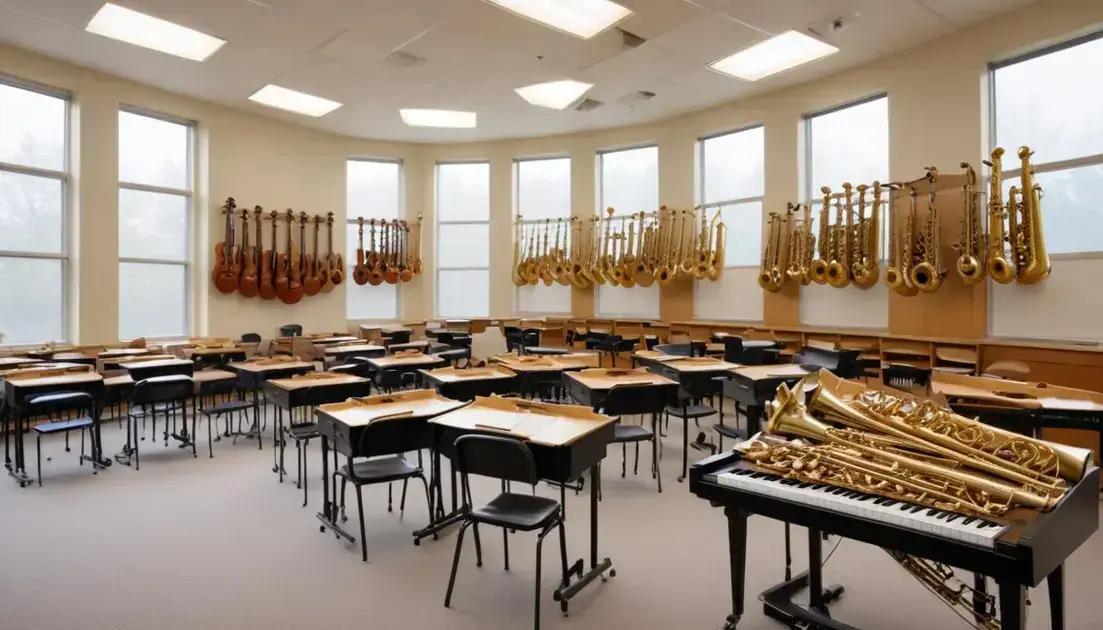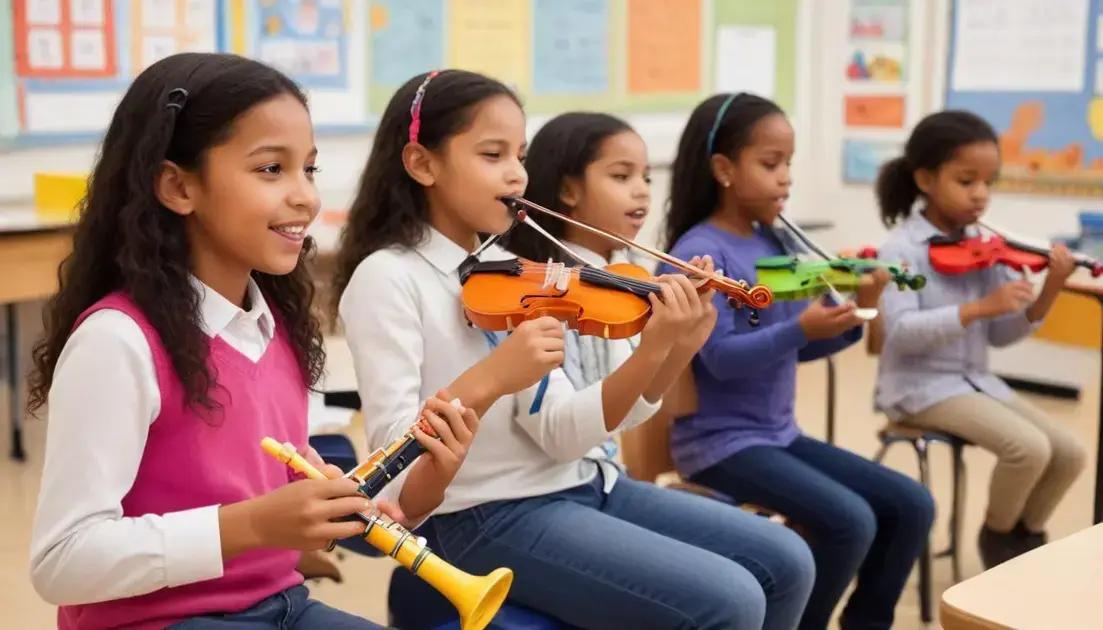School musical instruments: how to choose and get the most out of them

When it comes to school musical instruments, making the right choice can transform your music education program. Whether you’re a music teacher, administrator, or parent, understanding how to select and maintain these instruments can make the difference between a thriving music program and a struggling one.
Essential instruments for school music programs
A well-rounded school music program requires a carefully curated selection of instruments to provide students with comprehensive musical education. The foundation typically includes wind instruments like flutes, clarinets, and trumpets, which are excellent for developing breath control and finger dexterity.
String instruments form another crucial category, with violins and cellos being particularly valuable for teaching pitch accuracy and ensemble playing. The percussion section should include both melodic instruments like xylophones and rhythmic ones such as drums and tambourines.
Core Instruments for Beginners
For starting students, recorders and keyboards serve as excellent teaching tools. Recorders help develop basic music reading skills and finger coordination, while keyboards provide visual representation of musical scales and harmonies.
Advanced Program Instruments
As programs grow, consider adding French horns, trombones, and bass instruments like tubas and double basses. These help create fuller ensemble sounds and provide opportunities for students to specialize in unique instruments.
Electric instruments such as keyboards and bass guitars can also enhance modern music education, bridging classical and contemporary styles. Remember to maintain a balanced ratio of different instrument types to ensure proper ensemble sound and provide diverse learning opportunities.
Factors to consider when selecting instruments
Selecting the right school musical instruments requires careful consideration of multiple factors to ensure successful learning outcomes. Student age and physical characteristics play crucial roles – younger students may need smaller-sized instruments that match their physical capabilities.
Physical Considerations
Hand size affects the ability to handle certain instruments comfortably. For instance, students with smaller hands might struggle with larger brass instruments but excel with appropriately sized string instruments or woodwinds. Consider the weight of instruments too, as heavy instruments can cause fatigue during practice sessions.
Budget and Durability
Quality matters, but it needs to balance with budget constraints. Look for student-grade instruments from reputable manufacturers that offer durability without breaking the bank. Consider both initial costs and long-term maintenance expenses when making selections.
The instrument’s construction material significantly impacts its longevity in a school setting. Plastic recorders and composite materials often withstand student use better than their wooden counterparts. For brass instruments, choose models with reinforced joints and sturdy valve mechanisms.
Educational Goals
Match instruments to your curriculum needs. If your program focuses on orchestra music, prioritize string instruments. For marching bands, select instruments that are portable and weather-resistant. Consider instruments that offer clear progression paths as students advance in their musical journey.
Don’t forget about storage space and transportation requirements. Larger instruments like tubas and timpani need dedicated storage areas, while smaller instruments can be more easily accommodated in standard music room storage solutions.
Budget-friendly options for school music departments
Finding affordable musical instruments for schools doesn’t mean compromising on quality. Start by exploring rental programs that offer bulk discounts for educational institutions. Many suppliers provide special pricing for schools, making it easier to acquire multiple instruments at once.
Cost-Effective Instrument Options
Consider purchasing refurbished instruments from reputable dealers. These instruments undergo professional restoration and often come with warranties, offering significant savings compared to new models. Student-grade instruments from established brands like Yamaha and Pearl provide reliable quality at reasonable prices.
Smart Purchasing Strategies
Look into instrument packages that include essential accessories like cases, cleaning kits, and basic maintenance tools. Buying in bulk during off-season periods (usually summer) can lead to better deals. Some manufacturers offer educational discounts of up to 40% off retail prices.
Create a rental-to-own program for students, where monthly payments contribute to eventual instrument ownership. This helps distribute costs while ensuring instruments remain well-maintained. Consider partnering with local music stores for special school rates and maintenance agreements.
Alternative Funding Sources
Explore grant opportunities specifically designed for school music programs. Organizations like VH1 Save The Music Foundation and Mr. Holland’s Opus Foundation provide instrument grants to qualifying schools. Local businesses and parent-teacher associations often support fundraising initiatives for music departments.
Start with essential instruments and gradually build your collection. Focus on versatile instruments that can serve multiple purposes, such as keyboards that can function both as piano practice tools and for music theory classes.
Maintenance and care guidelines for school instruments
Proper maintenance of school musical instruments extends their lifespan and keeps them in optimal playing condition. Daily care routines should include wiping down instruments after use and storing them properly in their designated cases.
Basic Cleaning Procedures
For wind instruments, remove moisture after each use with cleaning swabs and cloths. String instruments need regular wiping to remove rosin dust, while brass instruments require valve oil and slide grease applications. Keep a supply of cleaning materials easily accessible in the music room.
Regular Maintenance Schedule
Create a maintenance calendar that tracks when each instrument needs professional servicing. Woodwinds typically need pad replacement every 1-2 years, while brass instruments should undergo chemical cleaning annually. String instruments require regular bridge adjustments and bow rehairing.
Train students in basic maintenance practices like proper assembly and disassembly techniques. This includes showing them how to cork grease woodwind joints, clean mouthpieces, and handle delicate parts with care.
Preventive Care
Monitor humidity levels in storage areas, as extreme conditions can damage wooden instruments. Use dehumidifiers or humidifiers as needed. Keep instruments away from direct sunlight and heating vents that can cause warping or cracking.
Implement a sign-out system to track instrument usage and maintenance history. This helps identify which instruments need attention and ensures accountability for proper care. Schedule regular inspections to catch minor issues before they become major repairs.
Best beginner instruments for young students

Starting young students on the right musical instruments can make or break their interest in music. The recorder remains a trusted first instrument, teaching fundamental music reading and finger coordination without overwhelming beginners.
Ideal Starter Instruments
Electronic keyboards offer an excellent entry point, providing visual aids for learning notes and immediate sound feedback. Their adjustable volume and headphone options make practice sessions more manageable for both students and teachers.
Small-sized string instruments like 1/4 and 1/2 violins allow young students to develop proper playing technique while accommodating their smaller frames. Many manufacturers now produce lightweight versions specifically designed for children.
Percussion Options
Basic percussion instruments like xylophones and metallophones help develop rhythm skills and pitch recognition. Hand drums and tambourines teach basic beat keeping and coordination while being fun and engaging for young learners.
Wind Instruments for Beginners
Student-model flutes and clarinets made from durable materials work well for introducing wind instruments. These instruments come with modified keys and ergonomic designs to help small hands reach all positions comfortably.
Look for instruments with special features like simplified finger positions, lightweight materials, and break-resistant parts. Many educational instruments now come in bright colors that appeal to younger students while maintaining good sound quality.
Group playing and ensemble instrument selection
Creating balanced musical ensembles requires careful instrument selection to achieve harmonious group performances. Start with a core foundation of instruments that complement each other while providing opportunities for all skill levels.
Balanced Ensemble Planning
For beginning ensembles, maintain a proper ratio of instruments – typically more strings and woodwinds than brass instruments. Include enough bass instruments to support the overall sound, such as cellos, bass clarinets, and tubas.
Consider the acoustic properties of your performance space when selecting ensemble instruments. Larger rooms may require more brass instruments, while smaller spaces work better with lighter woodwind and string combinations.
Mixed Ability Groups
Create opportunities for students of different skill levels to play together by selecting pieces with varied part difficulties. Choose instruments that allow for both melody and accompaniment roles, enabling students to switch between leading and supporting parts.
Modern Ensemble Options
Include versatile instruments like keyboards and acoustic guitars that can bridge different musical styles. These instruments help create contemporary ensemble opportunities while supporting traditional arrangements.
Factor in the visual appeal of your ensemble during performances. Arrange instruments to showcase all sections while maintaining practical communication between players. Position conductors where all students can see them clearly, especially during important musical transitions.
Storage and transportation solutions
Proper storage and transportation of school musical instruments are crucial for maintaining their condition and extending their lifespan. Well-organized storage systems protect instruments while making them easily accessible for daily use.
Storage Solutions
Install adjustable shelving units designed specifically for musical instruments, with padded surfaces to prevent scratches. Use instrument racks with individual slots for smaller instruments like violins and clarinets, while providing floor space for larger items such as tubas and timpani.
Implement a climate control system in storage areas to maintain consistent temperature and humidity levels. Wooden instruments especially need protection from environmental changes that can cause warping or cracking.
Transportation Systems
Invest in heavy-duty instrument carts with rubber wheels for moving multiple instruments safely between practice rooms and performance venues. Use specialized cases with extra padding for delicate instruments, and consider stackable cases to maximize transport space.
Organization Methods
Create a labeled storage system using color-coding or numbered slots to help students quickly locate their instruments. Keep frequently used instruments at easily accessible heights, while storing seasonal or backup instruments in higher spaces.
Set up a check-out system using digital tracking or traditional log books to monitor instrument movement. Include designated areas for instrument cases and personal belongings to prevent cluttering of main storage spaces.
Tips for instrument longevity in school settings
Extending the life of school musical instruments requires a combination of proper handling techniques and preventive maintenance strategies. Regular attention to small details can prevent major repairs and keep instruments playing their best.
Daily Care Practices
Establish clear handling protocols for students, including proper assembly and disassembly procedures. Create cleaning stations with instrument-specific supplies, and teach students to wipe down instruments after each use, removing fingerprints and moisture that can lead to corrosion.
Environmental Protection
Install humidity control systems in storage areas to maintain optimal conditions between 45-55% relative humidity. Keep instruments away from direct sunlight and heating vents that can cause wood to crack or finish to fade. Use instrument stands during breaks to prevent accidental drops.
Preventive Maintenance
Schedule regular professional maintenance checks at least twice per school year. Keep detailed maintenance logs for each instrument, tracking repairs, part replacements, and cleaning schedules. Replace worn parts promptly before they cause damage to other components.
Train music staff in basic repair techniques for common issues like loose screws, stuck valves, or minor adjustments. Stock essential repair supplies and tools for quick fixes that prevent bigger problems. Create a rotation schedule for deep cleaning and professional servicing based on instrument type and usage frequency.
Implement a student responsibility program where learners earn privileges through demonstrated care of instruments. This encourages better treatment of equipment while teaching valuable maintenance skills.
Making the most of school musical instruments
Investing in quality school musical instruments is just the beginning of creating a successful music education program. By carefully selecting appropriate instruments, implementing proper maintenance routines, and establishing effective storage solutions, schools can build a lasting musical legacy that serves students for years to come.
Remember that the key to successful instrument management lies in balancing budget constraints with quality requirements, while maintaining consistent care practices. Whether you’re starting a new music program or enhancing an existing one, these guidelines will help create an environment where students can focus on their musical development.
With proper planning, regular maintenance, and thoughtful organization, school musical instruments can inspire generations of young musicians while providing excellent value for educational investments. The music-making journey becomes more rewarding when instruments are well-chosen, properly maintained, and carefully preserved.





